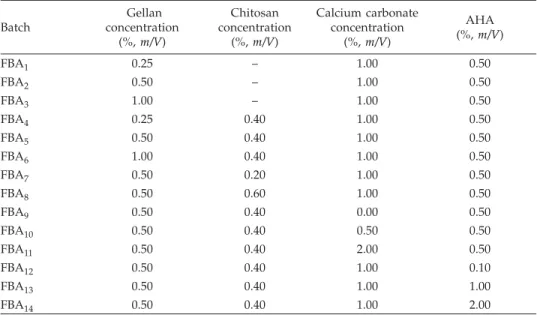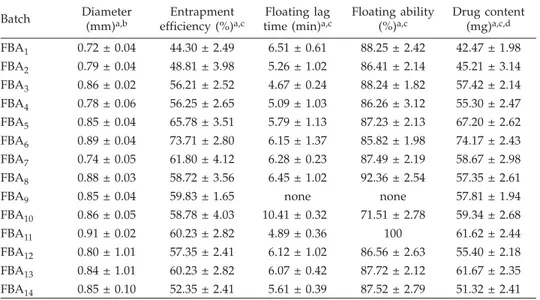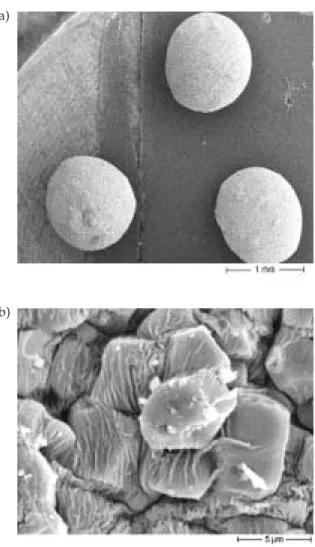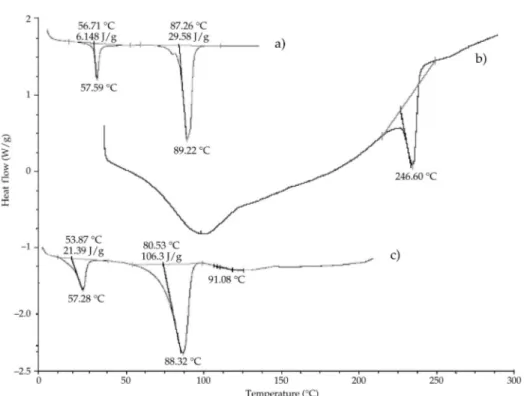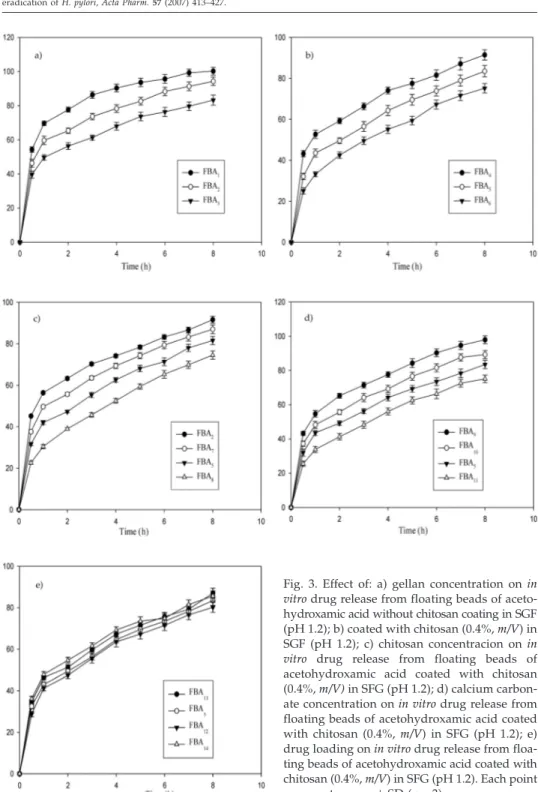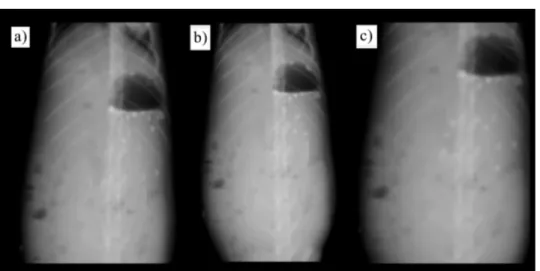Drug delivery systems that can precisely control the release rate of target drug to a specific body site have had an enormous impact on the healthcare system. In addition to drug formulations that deliver the drug for a prolonged period of time, it is important for efficient therapy to achieve spatial placement of the dosage form in the gastrointesti-nal tract (GIT). Site-specific drug delivery, using novel formulation designs, would im-prove local therapy in the GIT, optimize systemic absorption and minimize premature drug degradation (1). Stomach-specific antibiotic drug delivery, for instance, would be highly beneficial in the treatment ofHelicobacter pyloriinfection in peptic ulcer disease (2–4).
10.2478/v10007-007-0033-5
Preparation and
in vitro
characterization of gellan
based floating beads of acetohydroxamic acid for
eradication of
H. pylori
PARAUVATHANAHALLI SIDDALINGAM RAJINIKANTH
BRAHMESHWAR MISHRA* Department of Pharmaceutics Institute of Technology, Banaras Hindu University, Varanasi-221005, India
Accepted October 22, 2007
Gellan based floating beads of acetohydroxamic acid (AHA) were prepared by the ionotropic gellation me-thod to achieve controlled and sustained drug release for treatment of Helicobacter pylori infection. The prepared beads were evaluated for diameter, surface morphology and encapsulation efficiency. Formulation parameters like concentrations of gellan, chitosan, calcium carbonate and the drug influenced thein vitrodrug release charac-teristics of beads. Drug and polymer interaction studies were carried out using differential scanning calorimetry. Chitosan coating increased encapsulation efficiency of the beads and reduced the initial burst release of the drug from the beads. Kinetic treatment of the drug re-lease data revealed a matrix diffusion mechanism. Pre-pared floating beads showed good antimicrobial activity (in vitro H. pyloriculture) as potent urease inhibitors.In conclusion, an oral dosage form of floating gellan beads containing AHA may form a useful stomach site specific drug delivery system for the treatment ofH. pylori infec-tion.
Keywords: acetohydroxamic acid, gellan beads, controlled release, floating drug delivery, stomach-specific delivery,
Helicobacter pylori
In recent years, the number of individuals (more than 60% of adults in industriali-zed countries) suffering from acid peptic disease and gastric adenocarcinoma caused by H. pylorihas increased (5). Current strategies aimed at eradication ofH. pyloriinfection from patients rely on triple therapy that includes an anti-secretory agent in combination with two antibiotics, but these regimes are not wholly effective and patient compliance, side effects and bacterial resistance are major drawbacks of the therapy. This is due to the fact that the organism remains exclusively on the luminal surface of the gastric mucosa under the mucous gel layer. Thus, the access of antimicrobial drugs to the site is restricted both from the stomach and from the gastric blood supply (6, 7). Also, the antibiotics are not delivered to the site of infection in effective concentration and in fully active form by the conventional drug delivery systems (4). Despite the multi-antibiotic therapy, different therapeutic strategies have been examined to completely eradicateH. pylorifrom the stomach. Drug delivery to the site of residence in the gastric mucosa may improve the efficacy of the current and emerging treatments. Gastric retentive delivery systems potentially allow increased penetration of the mucus layer and therefore increa-se drug concentration at the site of action (6, 8).
To overcome the problems, we have proposed a concept based on a floating drug delivery system with floating site-specific drug delivery. It is necessary to design a drug delivery system that could not only curtail and alleviate the shortcomings of conven-tional drug delivery vehicles, but also deliver the antimicrobial agent to the infected cell lines. The drug, acetohydroxamic acid (AHA) inhibits cytoplasmic, which plays an im-portant role in the chemotactic motility ofH. pylori(9). As AHA is a small molecule (mo-lecular mass, 75.07), it can permeate intact bacterial cells and effectively inhibit the urease activity ofH. pylori.Freely diffusible AHA inhibits over 95% of urease activity af-ter 10 min (10, 11). Gellan gum is a bacaf-terial anionic deacetylated polysaccharide secre-ted byPseudomonas elodea. Due to its characteristic property of temperature-dependent and cation-induced gelation (12), gellan was selected as a matrix polymer for the prepa-ration of AHA beads in the formulation. The present work is therefore aimed develop-ing of anti-H. pyloriagent (antiurease) AHA-loaded gellan floating beads coated with chitosan for stomach-specific drug delivery for eradication ofH. pylori.
EXPERIMENTAL
Materials
Acetohydroxamic acid (AHA) and gellan (Gelrite) were purchased from Sigma-Al-drich Chemicals (India). Chitosan was a generous gift sample of the Centre for Fisheries and Research Institute (India). Brain heart infusion, fetal calf serum, andCampylobacter selective media (Skirrow Supplement) were purchased from Himedia, India. All other reagents were of analytical grade.
Methods
Preparation of beads. –The beads were prepared by the ionotropic gelation technique. Gellan solution (0.25–1.0%,m/V) was prepared by dissolving the gellan in deionized
wa-ter by heating at 90 °C. Different concentrations of the drug (0.1–2.0%,m/V) and calcium carbonate (0.5–2.0%,m/V) were dissolved/dispersed uniformly in 50 mL of gellan solu-tion below 40 °Cm/Vunder continuous stirring. The stirring was continued after com-plete addition until a uniform dispersion was obtained. The resultant homogeneous bubble free slurry dispersion was dropped through a 21G syringe needle into 100 mL of calcium chloride solution (1.5%), which was kept under stirring to improve the mechan-ical strength of the beads and also to prevent aggregation of the formed beads. Immedi-ate formation of small gelled beads took place; after 5 minutes of curing time, the for-med beads were collected by filtration and dried at 40 °C. The gellan beads coated with chitosan were prepared by dropping the gellan slurry containing different amounts of drug and calcium carbonate into 100 mL of calcium chloride (1.5%,m/V) with chitosan dissolved in it at various concentrations (0.2–0.6%,m/V). Then the beads were collected and dried as mentioned above.
Morphology and particle size analysis. –Particle size of the prepared beads was deter-mined using an optical microscope (Model BH-2, Olympus, Japan) fitted with a stage and an ocular micrometer. Twenty dried beads were measured for calculating the mean diameter of beads. The shape and surface morphological examination of the surface structure of dried beads were carried out by scanning electron microscopy (SEM-JEOL Model 8404, Japan at magnification of 500x).
In vitrofloating properties of gellan beads. –Thein vitrofloating study was performed using a USP 24 dissolution apparatus II (13) having 500 mL of simulated gastric fluid (SGF, pH 1.2). The medium temperature was kept at 37 ± 0.5 °C. The floating gellan beads (1.0 g beads) were soaked in the dissolution medium and the medium was agitated with a paddle at 50 rpm. After agitation, the beads that floated on the surface of the medium and those that settled down at the bottom of the flask were recovered separately. The floating percentage was estimated by visual observation.
Entrapment efficiency of beads. –The drug content in gellan beads was determined by the reported method with a slight modification (14). Briefly, the dried beads (100 mg) were allowed to disintegrate in 50 mL of phosphate buffer (pH 7.2) for 4 h. The whole dispersion of beads was sonicated at 125 W for 30 min (Imeco Sonifier, Imeco Ultraso-nics, India) and the solution was filtered through a 0.45-µm filter. Then the polymeric debris was washed twice with fresh solvent (phosphate buffer) to extract any adhering drug. The drug content of filtrate and washings was determined spectrophotometrically at 503 nm (Shimadzu, UV/Visible 1601, Japan). Each sample determination was made in triplicate.
Differential scanning calorimetry (DSC). –Differential scanning calorimetry (DSC) was performed on pure drug, placebo beads, and drug-loaded beads. DSC measurements were done on modulated DSC (Q 1000 TA equipped with software Pyris 6.0, USA). About 3.0 mg of sample was placed in an aluminium pan and then hermetically sealed with an aluminium lid. The thermograms were obtained at a scanning rate of 5 °C min–1over a
temperature range of 40 to 150 °C under an inert atmosphere flushed with nitrogen at a rate of 20 mL min–1. All tests were performed twice.
Measurement ofin vitro drugrelease. –The release of AHA from the floating beads was determined using a USP 24 dissolution test apparatus I with a basket (13). A weighed quantity of beads equivalent to 100 mg of AHA was placed in the dissolution basket and the basket was placed in 500 mL dissolution medium. The dissolution medium having 500 mL of simulated gastric fluid (pH 1.2) was maintained at 37±0.5°C (3). Five mL of sample was withdrawn at different time intervals and replaced with the same volume of freshly prepared dissolution medium. The drug content was measured at 503 nm. These experiments were conducted in triplicate.
In vivofloating efficiency (X-ray) study. –Thein vivostudy was carried out by admi-nistering floating beads to rabbits and monitoring them by a radiological method. Six healthy albino rabbits of either sex, weighing 2–2.4 kg (2.2 ± 0.3 kg) were used for the present study. The animals were housed in individual cages, and the experiments were conducted in a sanitized room at a temperature maintained at around 24 °C. Food was withdrawn 12 h prior to the study with waterad libitum. To make the beads radiopaque, 1.5 g of barium sulfate was incorporated into polymeric solution (the same formulation composition of FBA2was used to prepare radiopaque beads) and radiopaque beads
were prepared using a similar procedure to that mentioned in the preparation of beads. Twenty beads were administered through oral gastric tube with 25 mL water in fasted state. Afterwards, the animals were not allowed to eat or drink throughout the study (up to 6 h). The beads loaded with barium sulfate showed the samein vitrobuoyancy as the unloaded units (data not shown). At every hour interval, 10 mL of water was admi-nistered to animals throughout the study. Before taking X-ray photographs, the animals were placed/held in upright posture. The position of the beads in the rabbit’s stomach was monitored by X-ray photographs (Siregraph-B, Siemens, Germany) of the gastric gion at different time intervals (at 1, 4 and 6 h ) for 6 h. The number of beads that re-mained buoyant on the surface of the gastric content and that of all the beads remaining inside the stomach (buoyant and non-buoyant) were observed visually from the X-ray photographs.
The protocol of the study was approved by Animals Ethical Committee of the Bana-ras Hindu University (Varanasi, India).
In vitrogrowth inhibition studies. –The bacterial strain used in this study was origi-nally isolated from a hospitalized human patient (aged 50 years) with gastric ulcer.In vi-trogrowth inhibition studies were performed on developed system using a broth culture ofH. pylori.H. pyloribroth culture was preformed in a brain-heart infusion containing 0.25% yeast extract and 10% fetal calf serum and supplemented with 0.4%Campylobacter selective supplement (Skirrow supplement).H. pyloristrain was grown in brucella broth at 37 °C after 7 days in a microaerophilic atmosphere (5% O2, 10% CO2, 85% N2). Growth
of the bacteria was monitored by measuring the optical density of broth cultures spec-trophotometrically at 600 nm. The number of bacteria was determined by OD with one optimal density unit corresponding to 108colony-forming unit (CFU) mL–1. The colonies
were identified asH pyloriby morphology and urease activity (2). To study the effect of formulations onH. pylorigrowth inhibition (GI), 10 mL of nutrient broth was inoculated with a loopful of theH. pylorifrom stock culture to make a final culture of 108CFU mL–1.
AHA plain drug and different formulations were added to the tubes and all the tubes were incubated at 37 °C in a microaerophilic atmosphere. Acetohydroxamic acid was
used at a final concentration of 14 mmol L–1(14 mmol L–1is approximately four fold of
the reportedMIC50for H. pyloriurease) (10).
The culture containing tubes were shaken at 100 rpm at 37 °C in a microaerobic at-mosphere in an incubator. Then, 100 µL of nutrient broth containing AHA and different AHA formulations was removed at various time points (4, 8, 12 and 24 h) and serial di-lutions were plated on modified Skirrow’s medium. The agar plates were incubated for 4 days at 37 °C under microaerobic conditions in GasPak (BD Diagnostic Systems, USA). The viable cell counts for each sample were calculated by counting the number of colo-nies on the agar plates.
Statistical analysis
Statistical evaluation of the data was performed using the analysis of variance (ANOVA).
RESULTS AND DISCUSSION Particle size and morphology of beads
The formulation composition and physico-chemical properties of the various bat-ches of the prepared AHA floating beads are shown in Tables I and II, respectively. The scanning electron micrographs (SEM) of the beads are shown in Figs. 1a and b. The SEM
Table I. Formulation variables of the prepared floating beads of acetohydroxamic acid
Batch Gellan concentration (%,m/V) Chitosan concentration (%,m/V) Calcium carbonate concentration (%,m/V) AHA (%,m/V) FBA1 0.25 – 1.00 0.50 FBA2 0.50 – 1.00 0.50 FBA3 1.00 – 1.00 0.50 FBA4 0.25 0.40 1.00 0.50 FBA5 0.50 0.40 1.00 0.50 FBA6 1.00 0.40 1.00 0.50 FBA7 0.50 0.20 1.00 0.50 FBA8 0.50 0.60 1.00 0.50 FBA9 0.50 0.40 0.00 0.50 FBA10 0.50 0.40 0.50 0.50 FBA11 0.50 0.40 2.00 0.50 FBA12 0.50 0.40 1.00 0.10 FBA13 0.50 0.40 1.00 1.00 FBA14 0.50 0.40 1.00 2.00
results revealed that all the AHA-loaded floating beads were discrete and spherical in shape with rough outer surface (Figs. 1a and b). However, the chitosan coated AHA beads had outer rough surface with a number of minor wrinkles (Fig. 1b). This is due to the formation of a thin layer coat of chitosan over the beads, which caused several wrin-kles during the drying due to dehydration of the chitosan membrane surrounding the beads (Fig. 1b). The bead diameter varied from 0.72 ± 0.04 to 0.91 ± 0.02 mm for different batches. The results indicate that as the amount of gellan and calcium carbonate increa-sed, the size of beads also proportionally increased (Table II). This could be attributed to the increase in micro-viscosity of the polymeric dispersion due to increasing gellan con-centration, which eventually led to formation of bigger beads. The mean diameter of prepared beads marginally increased with an increase in drug loading and chitosan con-centration. This could be attributed to drug solubility in water and formation of a thin chitosan coating over the beads due to its ionic interaction, respectively.
In vitrofloating properties
The floating ability of the prepared formulations was evaluated in SGF (pH 1.2) us-ing a USP 24 dissolution apparatus II (13). The time the formulation took to emerge on the medium surface (floating lag time) and the percentage of floating beads on the disso-lution medium surface were evaluated and are shown in Table II. Upon contact with an acidic medium, gelation and cross-linking by Ca2+ions occurred to provide a gel barrier
Table II. Physico-chemical characteristics of the prepared floating beads of acetohydroxamic acid
Batch Diameter (mm)a,b
Entrapment efficiency (%)a,c
Floating lag time (min)a,c
Floating ability (%)a,c Drug content (mg)a,c,d FBA1 0.72 ± 0.04 44.30 ± 2.49 6.51 ± 0.61 88.25 ± 2.42 42.47 ± 1.98 FBA2 0.79 ± 0.04 48.81 ± 3.98 5.26 ± 1.02 86.41 ± 2.14 45.21 ± 3.14 FBA3 0.86 ± 0.02 56.21 ± 2.52 4.67 ± 0.24 88.24 ± 1.82 57.42 ± 2.14 FBA4 0.78 ± 0.06 56.25 ± 2.65 5.09 ± 1.03 86.26 ± 3.12 55.30 ± 2.47 FBA5 0.85 ± 0.04 65.78 ± 3.51 5.79 ± 1.13 87.23 ± 2.13 67.20 ± 2.62 FBA6 0.89 ± 0.04 73.71 ± 2.80 6.15 ± 1.37 85.82 ± 1.98 74.17 ± 2.43 FBA7 0.74 ± 0.05 61.80 ± 4.12 6.28 ± 0.23 87.49 ± 2.19 58.67 ± 2.98 FBA8 0.88 ± 0.03 58.72 ± 3.56 6.45 ± 1.02 92.36 ± 2.54 57.35 ± 2.61
FBA9 0.85 ± 0.04 59.83 ± 1.65 none none 57.81 ± 1.94
FBA10 0.86 ± 0.05 58.78 ± 4.03 10.41 ± 0.32 71.51 ± 2.78 59.34 ± 2.68 FBA11 0.91 ± 0.02 60.23 ± 2.82 4.89 ± 0.36 100 61.62 ± 2.44 FBA12 0.80 ± 1.01 57.35 ± 2.41 6.12 ± 1.02 86.56 ± 2.63 55.40 ± 2.18 FBA13 0.84 ± 1.01 60.23 ± 2.82 6.07 ± 0.42 87.72 ± 2.12 61.67 ± 2.35 FBA14 0.85 ± 0.10 52.35 ± 2.41 5.61 ± 0.39 87.52 ± 2.79 51.32 ± 2.41 aMean ± SD. bn= 20. cn= 3.
at the surface of the formulation. The calcium carbonate effervesced, releasing carbon di-oxide and calcium ions. The released carbon didi-oxide was entrapped in the gel network producing buoyant formulation and then calcium ion reacted with gellan producing a cross-linked three-dimensional gel network that restricted further diffusion of carbon di-oxide and drug molecules and resulted in an extended period of floating and drug re-lease (16–18). The floating ability of the formulation mainly depended on calcium car-bonate and gellan concentrations. The control beads (without calcium carcar-bonate) sank uniformly in the medium. The beads containing 0.5 to 2.0% of the gas-forming agent demonstrated good floating ability (71–100% of floating). The floating lag time for this system was in the range of 4–10 min. The lowest concentration of calcium carbonate which makes the beads float throughout the drug release study was found to be 0.5% (m/V) at all polymer levels.
Fig. 1. SEM photograph of the prepared floating beads of acetohydroxamic acid: a) prepared AHA beads (FBA2), b) sur-face morphology of chitosan coated AHA beads (FBA2).
a)
On increasing the calcium carbonate concentration, the floating lag time was redu-ced and the duration of floating was increased (Table II). The increase in the amount of Ca2+and consequently in the amount of CO
2evolved are responsible for the observed
reduction in the floating lag time and increased duration of floating. Similarly, an in-crease in the polymer concentration resulted in dein-creased lag time of the prepared beads (Table II). In SGF, the beads containing 2.0% (m/V) calcium carbonate exhibited a good floating ability; about 100% beads floated after the lag time of approximately 4 min (Ta-ble II). On increasing the CaCO3concentration from 0.75 to 2.5% (m/V), the floating lag time of AHA beads was reduced from 10 to 4 min (Table II). Almost all the prepared beads were floating for > 8 h in SGF pH 1.2 (data not shown). Different drug concentra-tion did not produce any significant effect on floating properties of the beads; the beads remained buoyant even after the buoyancy test period.
Entrapment efficiency
The effects of various formulation parameters on the entrapment efficiency of the prepared floating beads are shown in Table II. The entrapment efficiency of the prepared floating beads varied from 44.3% for batch FBA1(gellan 0.25%,m/V, no chitosan coat) to
73.7% for batch FBA6 (gellan 1.0%,m/V coated with chitosan 0.4%, m/V). The
entrap-ment efficiency increased significantly (p< 0.05) with increasing polymer concentration, as shown in Table II. This is because the increase in the gellan concentration resulted in the formation of larger beads entrapping more drug. The entrapment efficiency of beads increased with increasing the drug loading up to 1.0% (m/V). However, increasing AHA concentration above 2.0% (m/V) caused a marginal decrease in the incorporation effi-ciency, suggesting that the quantity of gellan becomes insufficient to entrap the drug. The entrapment efficiency was also found to be proportionally increased with increasing chitosan concentration. This is due to the increasing thickness of chitosan coat formed over the beads which may encapsulate a larger amount of drug. This result is well corre-lated with similar results reported earlier for alginate-chitosan beads of timolol maleate (19). The method adopted for the preparation of beads could be responsible for the ob-served higher entrapment efficiency. No significant effect on entrapment efficiency of beads was observed with increasing concentration of calcium carbonate (Table II).
DSC studies
In an effort to investigate the possible physical and chemical interactions between drug and polymer, we have analyzed: (i) pure acetohydroxamic acid, (ii) placebo beads and (iii) drug-loaded beads using modulated DSC. The results are displayed in Fig. 2. The DSC thermogram showed a sharp endothermic peak at 89.22 °C for pure AHA as the melting point of the drug (Fig. 2a). In placebo beads, thermal transition at 246.60 °C can be seen, which is attributed to the melting point of the gellan polymer. In the DSC thermogram of the drug-loaded beads, the endothermic peak was observed at 88.32 °C as the melting point of the drug (Fig. 2c). The evaluation of the thermograms clearly re-vealed no physical interaction between the polymer and the drug in the beads. The anal-ysis of thermograms revealed no physical interaction between the polymer and the drug in the prepared beads.
In vitrodrug release
Thein vitrodrug release profiles of gellan floating beads of AHA with different po-lymer concentrations are shown in Figs. 3a and b. The rate and extent of AHA release from floating beads significantly decreased (p< 0.05) with an increase in gellan concen-tration. This could be attributed to the increase of gellan matrix density and in the diffu-sion path length which the drug molecules have to traverse (by formation of bigger sized beads). The drug release from these beads was characterized by an initial phase of high release (burst effect) due to good solubility of AHA in water. However, as gelation proceeded (cross-linking of gellan with Ca2+ions from calcium carbonate), the
remain-ing drug was released at a slower rate followed by a phase of moderate release. This bi-phasic pattern of release is a characteristic feature of matrix diffusion kinetics (20). The initial burst effect was considerably reduced with the increase in gellan concentra-tion (Fig. 3a). The initial burst effect from batches of chitosan-coated beads (FBA4, FBA5 and FBA6) was considerably reduced when compared to the corresponding batches of
chitosan non-coated beads (FBA1, FBA2and FBA3), as shown in Fig. 3b. The fact is that chitosan coating over the beads resulted in better incorporation efficiency and formed a thick coating layer around the beads. This could be the reason for the observed decrease in the burst effect.
Fig. 2. DSC theromograms of: a) pure acetohydroxamic acid, b) placebo beads, c) acetohydroxamic acid-loaded beads (FBA2).
Fig. 3. Effect of: a) gellan concentration onin vitrodrug release from floating beads of aceto-hydroxamic acid without chitosan coating in SGF (pH 1.2); b) coated with chitosan (0.4%,m/V) in SGF (pH 1.2); c) chitosan concentracion onin vitro drug release from floating beads of acetohydroxamic acid coated with chitosan (0.4%,m/V)in SFG (pH 1.2); d) calcium carbon-ate concentration onin vitrodrug release from floating beads of acetohydroxamic acid coated with chitosan (0.4%,m/V) in SFG (pH 1.2); e) drug loading onin vitrodrug release from floa-ting beads of acetohydroxamic acid coated with chitosan (0.4%,m/V) in SFG (pH 1.2). Each point represents mean±SD (n= 3).
Fig. 3c indicates the effect of chitosan concentration on the release properties of AHA from gellan beads. An increase in chitosan concentration in beads caused a signifi-cant (p< 0.05) retardation in the drug release of the beads as a result of an increase in the thickness of the coat of chitosan over the beads, thereby increasing the distance traveled by the drug molecule through the chitosan coat. Release rates of AHA from gellan beads with different amounts of calcium carbonate are shown in Fig. 3d. An increase in cal-cium carbonate content prolonged the release of AHA from the gellan matrix. This effect may be due to the internal ionotropic gelation effect of calcium carbonate. In acidic me-dium, the calcium carbonate dissolves and the ionized Ca2+ions then promote internal
gelation by cross-linking with the gellan and retarding the drug release from gellan ma-trix (21).
The effect of drug loading on AHA release from the prepared beads is shown in Fig. 3e. The results indicate that different drug loadings of beads did not produce any signifi-cant difference in the rate and extent of drug release from beads. However, an initial high release was observed with the formulation batch FBA14with higher drug loading.
In order to investigate the mechanism of drug release, the data were fitted to mod-els representing zero-order, first order and Higuchi’s square root of time (22). The exam-ination of the coefficient of determexam-ination (R2) indicated that drug release from the pre-pared beads followed a diffusion controlled mechanism, since theR2values for Higu-chi’s square root of time (from 0.9661 to 0.997) was always higher compared to zero-or-der (from 0.8604 to 0.9238) and to the first-orzero-or-der ones (from 0.9126 to 0.9613). Since the release from the prepared beads followed a biphasic profile, it was decided to use a more stringent test in order to distinguish between the mechanisms of drug release. The release data were fitted to the Peppas exponential model (23)Mt/M∞=Ktn, whereMt/M∞ is the fraction of drug released after timet, Kis the kinetic constant andnis the release exponent which characterizes the drug transport mechanism. Thenvalues were in the range of 0.3248–0.5653, indicating that all the prepared formulations followed the Fi-ckian diffusion controlled mechanism of drug release.
In vivofloating efficiency
The results of X-ray photographs of floating beads at different time intervals in rab-bits stomach are shown in Figs. 4a-c. One hour after dosing, the beads showed good floatability (~80%); 4 and 6 h after dosing about 60 and 50% of beads were found to be buoyant on gastric content, respectively, whereas the remaining beads were observed in a lower part of the stomach (Figs. 4b and c). The results clearly indicate that the pre-pared floating beads of AHA remained buoyant for at least 6 h in rabbits stomach and that they had good floatabilityin vivo.
In vitrogrowth inhibition studies
The effect of different drug-loaded, drug-free formulations (placebo) and plain AHA on bacterial growth was investigated at various time intervals for up to 24 hours and the results are shown in Fig. 5. The antimicrobial effect of formulations and plain drug were determined in terms of percentage growth inhibition (GI), which was calculated as the ratio of optical density (OD) of a given mixture against that of tubes containingH. pylori
alone. Placebo beads (control batch) did not exhibit any significant growth inhibition (Fig. 5).
In order to evaluate thein vitrogrowth inhibition of formulations againstH. pylori, two batches containing different drug concentrations (FBA1and FBA12) have been
se-lected. The growth inhibition of drug loaded formulations was compared with that of the drug alone. The percentage GI values for placebo, AHA, FBA1and FBA12were 3.6 ±
1.2, 69.0 ± 5.6, 56.3 ± 5.6 and 49.9 ± 6.7, respectively after 4 h incubation. After 8 hours of incubation with formulations FBA1and FBA12, the bacterial growth was reduced to 68.1
± 6.3% and 60.2 ± 5.2%, respectively (Fig. 5), whereas the AHA pure drug inhibited com-pletely theH. pylorigrowth. The AHA formulations achieved complete growth inhibi-tion only after 12 h of incubainhibi-tion. Continued incubainhibi-tion ofH. pylorifor up to 24 hours in Fig. 4. X-ray photographs of floating beads of AHA in the gastric region of rabbit after dosing of formulations in the fasted state: a) 1 h after dosing, b) 4 h after dosing, c) 6 h after dosing.
Fig. 5. Percentage ofH. pylorigrowth inhibi-tion (mean±SD,n= 3).¢Placebo beads,¢ AHA plain drug,¢FBA11,£FBA12.
the presence of AHA formulations inhibited completely the bacterial growth. This is due to the controlled delivery of AHA from formulations, meaning that the microorganism was exposed to a lower drug concentrations.
The floating beads containing AHA may show more efficacy inin vivo H. pylori clea-rance than pure AHA due to longer residence time of the formulation at the site in stom-ach whereH. pyloriresided. The results clearly indicate that the formulations showed good inhibition inin vitroculture. However, the time required for complete inhibition was shorter for AHA than for AHA formulations because of the direct exposure ofH. pylorito AHA. From the interaction and adsorption of the AHA formulations, the for-mulations effectively targeted the drug on theH. pylorisurface. Particularly, AHA inhib-its cytoplasmic urease that plays an important role in the chemostatic motility ofH. py-lori. Thus, it can be expected that the floating formulations with selected drug (AHA) will abolish all the mechanisms ofH. pylorisurvivalin vivoand may provide better treat-ment efficacy forH. pylorieradication.
CONCLUSIONS
The prepared gellan beads of AHA floated in SGF for a prolonged period of time and sustained drug release from the beads over a period of at least 8 h. Thein vivo float-ing efficiency of beads was satisfactory; beads were retained in rabbits stomach for ex-tended periods. Thein vitro H. pyloriinhibition study showed good antimicrobial activ-ity of formulations inH. pyloriculture.
From the results one can conclude that the gellan based floating beads containing AHA have a promising potential for delivering AHA at the stomach site and may be very useful forH. pylorieradication.
REFERENCES
1. A. Rubinstein and D. R. Friend,Site-specific Delivery to the Gastrointestinal Tract,inPolymeric Site-Specific Pharmacotherapy(Ed. A. J. Domb), Wiley, Chichester 1994, pp. 267–313.
2. N. Nagahara, Y. Akiyama, M. Tada, M. Nakao, M. Kitano and Y. Ogawa, Mucoadhesive micro-spheres containing amoxicillin for clearance ofHelicobacter pylori,Antimicrob. Agents Chemother. 42(1998) 2492–2494.
3. R. Hejazi and M. Amiji, Stomach-specific anti-H. pylori therapy. I. Preparation and characteri-zation of tetracycline-loaded chitosan microspheres,Int. J. Pharm. 235(2002) 87–94; DOI: 10. 1016/S0378-5173(01)00985-1.
4. R. B. Umamaheshwari, S. Jain and N. K. Jain, A new approach in gastroretentive drug delivery system using cholestyramine,Drug Deliv.10(2003) 151–160; DOI: 10.1080/713840399. 5. B. J. Marshall and J. R. Warren, Unidentified curved bacilli in the stomach of patients with
gas-tritis and peptic ulceration,Lancet1(1984) 1311–1315; DOI: 10.1016/S0140-6736(84)91816-6. 6. P. S. Rajinikanth, J. Balasubramanium and B. Mishra, Development and evaluation of a novel
floating in situ gelling system of amoxicillin for eradicating ofHelicobacter pylori,Int. J. Pharm. 335(2007) 114–122; DOI: 10.1016/j.ijpharm.2006.11.009.
7. C. K. Lin, P. I. Hsu and K. H. Lai, One-week quadruple therapy is an effective salvage regimen forHelicobacter pyloriinfection in patients after failure of standard triple therapy,J. Clin. Gastro-enterol.34(2002) 547–551.
8. R. B. Umamaheshwari, R. Suman and N. K. Jain, AntiHelicobacter pylorieffect of mucoadhesive nanoparticle bearing amoxicillin in experimental gerbils,APPS Pharm. Sci. Tech.5 (2004) article 32.
9. A. M. El. Nujumi, C. A. Dorrian, R. S. Chittajallu, W. D. Neithercut, K. E. L. McColl, Effect of in-hibition ofHelicobacter pyloriurease activity of acetohydroxamic acid on serum gastrin in duo-denal ulcer subjects,Gut32(1991) 866–870.
10. H. L. Mobley, L. T. Hu and P. Foxall,Helicobacter pyloriurease: Properties and role in patho-genesis,Scand. J. Gastroenterol. Suppl.187(1991) 39–46.
11. S. H. Phadnis, M. H. Parlow, M. Levy, D. Iher, C. M. Canldine, J. B. Connors and B. E. Dunn, Surface localization ofHelicobacter pyloriurease and a heat shock protein homolog requires bac-terial autolysis,Infect.Immun.64(1996) 905–912.
12. S. Miyazaki, N. Kawasaki, W. Kudo and D. Attwood, Comparison ofin situgelling formulation for oral delivery of cimetidine,Int. J. Pharm.220(2001) 161–168; DOI: 10.1016/S0378-5173(01) 00669-X.
13.United State Pharmacopeia 24 /National Formulary 19, USP Convention, Rockville, MD, 2002. 14. S. A. Agnihotri, S. S. Jawalkar and T. M. Aminabhavi, Controlled release of cephalexin through
gellan gum beads: Effect of formulation parameters on entrapment efficiency, size, and drug re-lease,Eur. J. Pharm. Biopharm.63(2006) 249–261; DOI: 10.1016/j.ejpb.2005.12.008.
15. I. Corthesy-Theulaz, N. Portal, M. Glauser, E. Saraga, R. Haas, J. P. Kraehenbushl, A. L. Blem and P. Michetti, Oral immunization withHelicobacter pylori urease B subunit as a treatment againstHelicobacterinfection in mice,Gastroenterology109(1995) 115–121; DOI: 10.1016/0016-5085(95)90275-9.
16. H. Grasdalen and O. Smidsroed, Gellation of gellan gum,Carbohyd.Polym.7(1987) 371–393; DOI: 10.1016/0144-8617(87)90004-X.
17. R. Chandrasekaran, L. C. Puigianer, K. L. Joyce and S. Arnotts, The influence of calcium ions, acetate and L-glycerate groups on the gellan double-helix,Carbohyd.Res.181(1988) 23–40; DOI: 10.1016/0008-6215(88) 84020-5.
18. R. Chandrasekaran and V. G. Thailambad, Cation interactions in gellan: An x-ray study of the potassium salt,Carbohyd.Polym.12(1990) 431–442; DOI: 10.1016/0144-8617(90)90092-7. 19. A. D. Sezer and J. Akbuga, Release characteristics of chitosan treated alginate beads. I.
Sustai-ned release of low molecular drug from chitosan treated alginate beads,J. Microencapsul.16 (1999) 195–203; DOI: 10.1080/026520499288636.
20. P. S. Rajinikanth, C. Sankar and B. Mishra, Sodium alginate microspheres of metoprolol tartrate for intranasal systemic delivery: development and evaluation,Drug Deliv.10(2003) 21–28; DOI: 10.1080/713840323.
21. J. Balasubramaniam and J. K. Pandit, Ion-activatedin situgelling systems for sustained oph-thalmic delivery of ciprofloxacin hydrochloride,Drug Deliv.10(2003) 185–191; DOI: 10.1080/ 713840402.
22. W. I. Higuchi, Analysis of data on the medicament release from ointments, J. Pharm. Sci.51 (1962) 802–804.
23. R. W. Korsmeyer, R. Gurney, E. Doelker, P. Buri and N. A. Peppas, Mechanisms of solute release from porous hydrophilic polymers,Int. J. Pharm.15(1983) 25–35; DOI: 10.1016/0378-5173(83) 90064-9.
S A E T A K
Priprava iin vitrokarakterizacija plutaju}ih zrnaca acetohidroksamske kiseline za iskorjenjivanjeH. pylori
PARAUVATHANAHALLI SIDDALINGAM RAJINIKANTH i BRAHMESHWAR MISHRA*
Metodom ionotropskog eliranja pripravljena su plutaju}a zrnca acetohidroksam-ske kiseline (AHA) na bazi gelana za kontrolirano i usporeno osloba|anje ljekovite tvari, namijenjena za lije~enje infekcija uzrokovanihHelicobacter pylori. Pripravljenim zrncima prou~avani su dijametar, površinska morfologija i sposobnost inkapsuliranja. Koncen-tracija gelana, kitozana, kalcijeva karbonata i ljekovite tvari utjecala je na osloba|anjein vitro. Interakcija izme|u ljekovite tvari i polimera pra}ena je diferencijalnom pretranom kalorimetrijom. Oblaganje zrnaca kitozanom pove}alo je u~inkovitost inkapsuliranja i smanjilo po~etno naglo osloba|anje. Osloba|anje ljekovite tvari slijedilo je mehanizam difuzije matriksa. Plutaju}a zrnca s AHA pokazala su antimikrobno djelovanjein vitro na kulturiH. pylorikao snani inhibitori ureaze. Moe se zaklju~iti da su plutaju}a zrnca s AHA na bazi gelana pogodna za specifi~nu isporuku u elucu te korisna u terapiji in-fekcija uzrokovanihH. pylori.
Klju~ne rije~i:acetohidroksamska kiselina, zrnca s gelanom, kontrolirano osloba|anje, plutaju}i pri-pravci za isporuku lijekova, specifi~na isporuka u elucu,Helicobacter pylori
